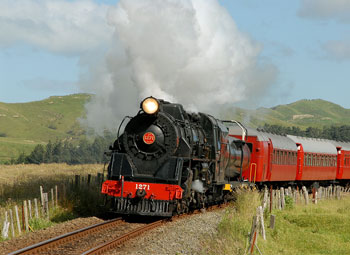 Laws of thermodynamics
The steam train pulling a load above is an excellent example of how the concept of thermodynamics function in regard to work. The scientific field of thermodynamics examines 'heat power' in regards to an ability to do work and the conversion of heat to other forms of energy. The laws and mathematical formulas of thermodynamics are as fundamental and absolute as science is able to produce. All things in the observable universe follow these laws including the weather on earth driven by the heat of the sun, plants producing food using solar energy, and biological functions in the cells of the body which use heat stored in molecules.
Laws of thermodynamics
The steam train pulling a load above is an excellent example of how the concept of thermodynamics function in regard to work. The scientific field of thermodynamics examines 'heat power' in regards to an ability to do work and the conversion of heat to other forms of energy. The laws and mathematical formulas of thermodynamics are as fundamental and absolute as science is able to produce. All things in the observable universe follow these laws including the weather on earth driven by the heat of the sun, plants producing food using solar energy, and biological functions in the cells of the body which use heat stored in molecules.
In the 17th century, it was accidentally discovered that heat could perform work. It was a surprise because until that time heat was only used to cook food, to melt and forge metals. Its a common experience to most of us to observe that a lid placed on container of boiling water is lifted up and even some times thrown off due to the steam. This is because, when water is converted into water vapor, it expands and occupies a greater volume.
This observation that steam could be used to push something, that is steam can do work, led to design of machine which converts energy stored in steam into mechanical work. Such a device is called an engine.
The study of heat and its transformation to mechanical energy is called Thermodynamics (in Greek meaning "movement of heat"). We have discussed earlier that work is done when energy is transferred from one object to another by mechanical means. In the same way heat is transferred from objects at higher temperature to those at lower temperatures. Thus, 'heat' is much like 'work'. Thermodynamics largely studies how heat can be used efficiently for moving bodies and doing work.
Thermodynamics employs only macroscopic notions – such as mechanical work, pressure and temperature – and their roles in energy transformations. Thermodynamics is a powerful theoretical science that bypasses the molecular details of the system altogether. Its foundation is the conservation of energy and the fact that heat flows spontaneously from hot to cold and not the other way round. It provides the basic theory of heat engines – from steam